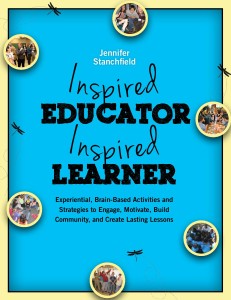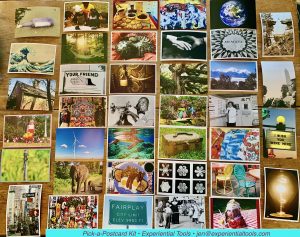Sep 01, 2014 Image and Postcard Introduction or “Strong Beginnings/Welcoming Ritual” Activities
 Excerpt from the Inspired Educator, Inspired Learner book by Jennifer Stanchfield
Excerpt from the Inspired Educator, Inspired Learner book by Jennifer Stanchfield
People are drawn in by colorful, novel, or intriguing objects whether they are tools, old toys, or items found in nature. People often share and reflect more readily when they can attach their thoughts and feelings to an item that can be touched and shown to a group during discussion, or described in reflective writing. As discussed in chapter one, brain research suggests that using metaphors, pictures and symbols helps cement lessons and transfer learning to everyday life and future learning (Willis, 2006, 2010). Throughout this chapter and chapter nine we will explore many metaphoric methods used for creating strong beginnings and facilitating meaningful reflection throughout lessons and programs. Here are a few of my favorite approaches for engaging groups from the moment they walk in the door.
Images/Postcards Purpose/Focus: active engagement, hook, “first five” or “do now,” conversation starter, context setting,
discussion or writing prompt, reflection, community building, figurative language, metaphor, emotional connection to learning, creativity/imagination, differentiation, multiple pathways to learning, choice,control and ownership, group norms
Materials: postcards, pictures from magazines or other images
I often use my “Pick-A-Postcard” collection as a way to draw learners into a classroom or group experience and create context around an upcoming discussion or lesson. It works well as a get-to-know-you and/or reflection activity on the first day of school, to start a new program, or as a transitional activity to welcome groups after a break between workshop sessions or school vacations. Images are an engaging way to explore the use of metaphor, figurative language, and perspective. They also make for intriguing creative writing prompts.
Facilitation Suggestions:
• Spread out the postcards/images so they are accessible to all group members.
• As participants enter the room, ask them to choose a card centered on a reflective, goal-setting, or conversation-starting topic such as:
› Choose a postcard that you would send to a friend to describe your summer break.
› What image represents a unique perspective or strength you bring to the group, class, or program?
› Choose and image that represents a goal or hope you have for the upcoming school year. You could invite students to write the hope or goal in a “Postcard to Their Future Self.
• Pose a question related to the group’s purpose for coming together. For example, when leading a program with a group of teachers you might use one of the following prompts or questions:
› Choose an image that represents a reason you are drawn to teaching.
› What card represents a quality you think is most important in a leader?
› What image represents a strength you bring to your work?
› Choose an image that represents a hope you have for the upcoming school year.
• For participants of an ongoing group or at the end of a course enter the room, have them choose a card describing their experience or lessons learned that they could send home as a future reminder. See Postcard to Your Future Self activity.
Facilitation Notes:
Having the cards available during pre-group gathering time or as an entry activity can help jumpstart conversations as group members get to know each other and set the tone for the program. Choosing a card gives people something to focus on as they transition into the workshop or classroom space. Depending on the group, participants can share their choice with a partner, or write about their choice. When group members are comfortable with each other, if it is appropriate, you can invite them to share with the whole group. I like to blend this activity with an interactive partner sharing activity such as Commonalities Mingle (see page 97) or Concentric Circles (see page 86).
Academic Variations:
Using images is not only great for building community or practicing social and emotional skills such as communication, insight, and reflection, but it can be a way to introduce, reinforce, or review academic material:
• A language arts teacher who wants to reinforce the idea of “theme” might lay out postcards and ask students to choose a card they are drawn to and then identify their interpretation of the card’s theme.
• In a creative writing course, students might be asked to write a story about their card or choose a card that describes them and use figurative language to explain why.
• A social studies or science teacher might choose images around a particular subject area and ask students to choose an image that resonates or speaks to them as a way to create interest.
Reference/Resource: Variations of object and image reflection activities are described in more detail in chapter eight and nine of the Inspired Educator, Inspired Learner. To purchase “Pick-a-Postcard” kits visit experientialtools.com.



No Comments